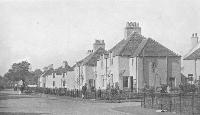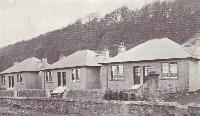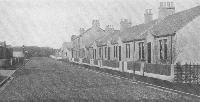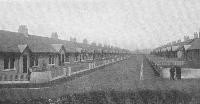Fife Housing
Evidence of Mr Samuel Hynds of the Fife and Kinross Miners' Association to the Royal Commission on Housing
West Quality Street, Burgh of Dysart
Block of nine houses for the most part consisting of two rooms each ; kitchen, 15 feet by 9 feet ; room, 12 feet by 8 feet ; height of ceilings, 7 feet.
The houses are very old and are in a dilapidated condition.
There are no coal cellars, no wash houses or sculleries, the water supply is outside, and there are only two water closets for the nine tenants and their families.
Fitzroy Square, Burgh of Dysart
Block of eighteen houses. Several of the houses are very damp.
The kitchen of one house visited measured 14 feet by 12 feet, the room 20 feet by 7 feet; the ceilings 8 feet high. There were nine persons living in the house.
The water supply is outside the houses, and there is only one washhouse for the eighteen tenants. It is in a state of disrepair.
The houses are very old, and not anything like up to modern requirements.
47 High Street, Burgh of Dysart
This property is said to belong to Messrs Smart & Archibald
There are four tenants - two rooms each. The stair is very low, being only 5 feet to the ceiling at one part
The kitchen in one house measured 12 feet square, the room 12 feet square, the ceiling being 8 1/2 feet high.
There is only one water closet and one wash-house, access to which can only be got to by going along the main street, a distance of 50 yards.
Slops have to be carried along the main street.
This property is in the centre of the town and is very old.
West Wemyss
There are about 40 houses in this village which are in an unsatisfactory condition.
They are very old houses, and the walls in many instances are not lathed. There is in many cases no lavatory accommodation whatever, the tenants having to go a distance along the shore for sanitary purposes.
Some of the houses have no washhouse available.
East Wemyss
Many of the houses in this village are comparatively modern, being fairly good houses, and are better than in most mining districts.
About 3 per cent, of the houses, however, might be described as unsatisfactory and unsuitable, there being a lack of sanitary conveniences, etc.
Coaltown of Wemyss
The houses in this village are, practically speaking, in the same condition as those at East Wemyss.
A few of the houses, however, are not in a satisfactory condition, there being no water closets, washhouses, etc., available.
The roads and lighting are disgraceful, especially during the winter months, and ought to be attended to at once.
Methil and Buckhaven
At least 170 houses in Buckhaven are unsatisfactory, and ought to be closed on account of defective drainage, damp walls, low ceilings (in some cases only 6 feet 4 inches high), floors, doors, and windows in a state of disrepair.
Some of the houses are greatly below the level of the street.
There is a great lack of water-closet accommodation in many instances. The condition of matters in many of these houses is disgraceful, the tenants having, in such cases, to go a long distance along the shore for sanitary purposes.
These houses are very old and should certainly be demolished.
Methilhill and Kirkland
The houses in these two districts are practically all unsatisfactory.
The houses in Kirkland are mostly all very old and are all owned by the Colliery Companies.
The sanitary conveniences are very insufficient and unsatisfactory. Ashpits and dry privies are in vogue and are a menace to public health.
The roads are unsatisfactory, and in Kirkland there is no lighting.
The houses at the cross roads are privately owned, and are rent by underground workings, and are very much damaged, requiring to be propped. They are in an un-safe condition.
Windygates
There are sixteen houses in an unsatisfactory condition in Windygates. They are all owned by the Colliery Company.
There is no lavatory accommodation for these sixteen houses, they have no sculleries and no wash-houses.
There are ashpits which should be done away with, as they are inimical to health.
There is no lighting in this village.
Kirkcaldy
There are a number of houses occupied by miners which are in an unsatisfactory condition, especially in Dunnikier, Dunnikier Rows, and Gallatown.
Many of these houses are very old and not in accordance with modern requirements.
Leven, Wellsgreen, Milton of Balgonie, and Coaltown of Balgonie
Many of the houses are old and ought to be replaced by modern buildings. Modern sanitary requirements ought to be introduced in many cases.
In Coaltown of Balgonie there is no lighting.
Feuing fates in Wemyss Parish are, in a number of cases, extortionate, ranging from £25 to £40 per acre.
Housing Built by Coal Companies
 Methilhill - houses built 1924-5 by Wemyss Coal Co Ltd. |
Methilhill - houses erected in 1914 by |
 Viewforth Cottages, Valleyfield. Houses built 1914-1915 by Fife Coal Co Ltd |  Wall Street, Denbeath - houses erected in |
Description of Houses at Valleyfield built by the Fife Coal Company
The village of Valleyfield is built on the Valleyfield Estate belonging to the life Coal Company. The site, which extends to 34 acres, has a southern aspect facing the Firth of Forth.
It is intended to build 240 houses, of which 192 will be two-roomed and 48 three-roomed houses. At present only 44 two-roomed and 4 three-roomed houses have been built, but another 48 houses are in course of construction. The houses are built in blocks of 24, and each block forms one side of a crescent. In the centre of the crescent it is proposed to plant a shrubbery. The road round the shrubbery is 20 ft. wide, the footpath in front of the gardens 6 ft. wide, and the front garden 18 ft. deep.
The space behind, the houses and between the crescent's is very, ample, and I understand is to be laid out in gardens, but nothing has been done yet. The space connecting the crescents and abutting on the main road, which is 60 feet wide, is to be reserved for shops. On the east side of the site two spaces are to be reserved for a church and a hall when the necessity for building these arises.
The two-roomed houses are one storey- in height and are of a very fair size for workmen's houses. Each house has a kitchen (12 ft. 6 in. x 12 ft. 9 in.) with two bed-recesses, room (12 ft. 6 in. x 12 ft.), small scullery (with sink and washing-boiler), a water-closet, and coal place. The ceilings of the rooms are 10 ft. high and that of the scullery 8 ft. 3 in. high.
The three-roomed houses are practically similar in plan, with an extra bedroom (12 ft. x 9 ft. 6 in.) with a bed-recess and an enlarged water-closet apartment containing a bath.
The walls of the houses are built of 12-in. hollow brickwork, cement harled on the outside and plastered on the hard inside. The roofs are covered with slating.
The drainage is connected to the present Valleyfield sewer. The water-supply is from the District Supply (Glenquey). The houses are at present lighted by means of oil lamps, but it is proposed to erect gas works in the future to supply this village.
The rent of the two-roomed house is 8s. plus 1s. for taxes, or 9s. per fortnight. This is equal to a rent of £11, 14s. per annum including taxes.
The rent of the three-roomed houses without bath is 10s. plus 1s. 3d. for taxes, or 11s. 3d. per fortnight. With a bath the rent is 11s. 6d. plus 1s. 5d. for taxes, or 12s. 11d. per fortnight. This is equal to a rent of £14, 12s. 6d. and £16, 15s. l0d. respectively per annum including taxes.
I have no note of the cost of these houses. I am not aware whether the company receives any return on the property or not.[Evidence presented by John Wilson to Royal Commission, 29th April 1913]
Townhill Village
The number of one-roomed houses examined was 81.
The average rental was £3 8s 4d per annum. The highest rental for any individual house was £4 0s 0d. per annum. The lowest rental for any individual house was £2 0s 0d. per annum.
The number of two-roomed houses examined was 333.
The average rental was . £5 13s 6 1/2 d. per annum. The highest rental for any individual house was £9 10s 0d. per annum. The lowest rental for any individual house was .£3 10s 0d. per annum.
In about 200 cases the rental included the taxes
Water Supply - 226 houses had a supply of water of their own, and 188 got their water supply from the washing-houses or wells in the street. In 1911 water was introduced into 76 houses.
Sanitary Accommodation
15 properties had private water closets
35 properties had one w.c. for two houses
27 properties had one w.c. for three
23 properties had one w.c. for four
6 properties had one w.c. for five
These conditions remain pretty much the same to this date.
In 48 of the houses there were damp walls and other defects; 23 of these, belonging to the Town Council, have been demolished, and 8, also belonging to the Council, will shortly be demolished.
Overcrowding - Two two-apartment houses were found to be over-crowded to the extent of 1 1/2 persons. One two-apartment house was found to be overcrowded to the extent of one person, and one to the extent of two persons. Two one-apartment houses were found to be overcrowded to the extent of one person.
Demolition & Erection of Houses - During the period from 1900 to 1912 there were demolished in Townhill 42 houses, and there were erected 77, being a net increase of 35, the majority of which are two-apartment houses.[Evidence presented by John Louitt Jack to Royal Commission, 29th April 1913]
Kingseat Village
The number of one-roomed houses examined was 11.
The average rental was £3 18s 0d per annum. The highest rental for any individual house was £4 per annum. The lowest rental for any individual house was £3 9s 4d per annum.
The number of two-roomed houses examined was 112.
The average rental was . £5 15s 6d per annum. The highest rental for any individual house was £8 per annum. The lowest rental for any individual house was £5 per annum.
Water supply - All the houses, with one exception, drew their water supply from wells in the street. In 1911, water was introduced into 30 houses. In 1912, water was introduced into another 30 houses.
Sanitary Accommodation - In 1906 the sanitary accommodation was chiefly the privy-midden system. Since then, however, the Town Council have introduced a drainage system into the village, at the cost of £281, and in 1911 7 houses were provided ,with water-closet accommodation, and in 1912 another 25 water-closets were erected
Overcrowding - In 1906 one two-apartment house was found to be overcrowded to the extent of one person. There is no overcrowding in Kingseat at present.
Demolition & Erection of Houses - I cannot find that there have been any houses demolished in this village between 1900 and 1912, but 6 two-roomed houses have been erected.[Evidence presented by John Louitt Jack to Royal Commission, 29th April 1913]
Colliery Houses Belonging to Dunfermline Town Council
The Town Council are the proprietors of certain collieries and colliery houses at Townhill. In 1897 they let Townhill Colliery, along with 97 colliers' houses, as one subject, to Mr Anthony Watson, on a nineteen years' lease. Subsequently, Mr Watson assigned the Lease to the West of Fife Coal Company, Limited.
In the year 1901, owing to the condition of the houses, an Agreement was entered into between the Town Council and the Company, whereby the Town Council obtained possession of 23 houses (which were demolished), granting the Company an abatement of £12, 10s. per annum in respect thereof. The Town Council, further, undertook to put the remainder of the houses into thorough order and repair, and to provide washing-houses, drainage, and sanitary conveniences therefor, and from time to time to execute all such alterations or additions to the structure of the colliers' houses and washing-houses, drainage and sanitary conveniences, as might be required.
In carrying out that obligation the Town Council spent a sum of £1242, upon which they receive interest at the rate of 6 per cent, per annum from the Company. The Company undertook to maintain the houses and offices in good order and repair, ordinary wear and tear excepted.
The great difficulty which the Town Council have had to face in connection with these houses is that in taking possession of the houses without the consent of their Colliery tenants, they were laying themselves open to considerable claims in respect therefor.
In the year 1910 the Colliery Company were in financial difficulties, and, as part of an arrangement, whereby the Company were enabled to effect a reconstruction, the Town Council stipulated that they should be relieved of the obligation undertaken by them in the original Colliery Lease and subsequent agreements, with reference to colliers' houses, and that they should be under no obligation to spend money to render these fit for occupation. In addition, the Company agreed to the Town Council taking immediate possession of 12 houses, which were demolished.
In respect of these arrangements the Town Council granted to the Company an annual abatement of £200. The Town Council, further, obtained right to take possession of, and close, any of the houses let to the Company by granting them a further abatement equivalent to the annual rent of any house which might be taken possession of.
Following upon that, the Town Council took possession of one house in 1911, and granted an abatement in respect thereof of £4, 6s. 8d. In May, 1912, the Town Council took possession of and closed 12 houses in Back Row, and granted the Company an abatement of £21, 7s. 8d.; and in January, 1913, the Town Council took possession of and closed 8 houses in first and second rows, in respect of which an abatement of £23, 8s. will be payable to the Company.
There therefore remain in existence 41 houses. There are still three and a half years of the Lease to run, and once that period expires the Town Council will have no difficulty in getting rid of the remainder of the houses. The collieries are all more or less worked out. In fact, the Town Council have just concluded an arrangement whereby the tenant of Muirbeath Colliery, or the Council, will be able to put an end to the Lease on giving three months' notice at any time.
The Local Government Board have been pressing the Council to demolish more of the colliery houses, but if that were done, it would only create difficult housing conditions. The Town Council are of opinion that it is hopeless to talk of a Municipal Housing Scheme in that district in this respect, that if the collieries are once brought to a stop, there will undoubtedly be a consider-able exodus from the village.
From what I have detailed above, it will be obvious that the Town Council have dealt with this matter to the very best of their ability, and at considerable loss to themselves. The whole matter is one which will right itself immediately the colliery lease expires, and the Town Council are doing everything in their power to have the condition of the houses made as satisfactory as possible.
It is a significant fact that on all the occasions on which I have visited these colliery houses, with the Property Committee, the occupants thereof have themselves had no complaint to make, and showed considerable resentment at being disturbed. I may say that where the Town Council take possession of, and demolish houses, they put the site up to public roup, and in this way new workmen's houses have actually been provided. There are at present six houses being erected in the village on the site of some old colliery buildings.[Evidence presented by John Louitt Jack to Royal Commission, 29th April 1913]
Newspaper Reports
Proposal To Erect 765 Houses In West Fife - Dunfermline District Committee have forwarded for the approval of the Scottish Board of Health plans for the erection in West Fife of 765 dwelling houses, of which 191 are houses of two apartments, 421 of three apartments, and 153 of four apartments . It is proposed to erect 210 of the houses at Kelty, 105 at Blairhall, 68 at Hill of Beath, 54 at Valleyfield, 36 at Oakley, 31 at Crossgates, 26 at Fordell, and 30 at Donibristle, all mining districts . Included in the scheme are what are described as rural houses, 73 in number, which are to be erected in various places throughout the district. [Scotsman 21 November 1919]
